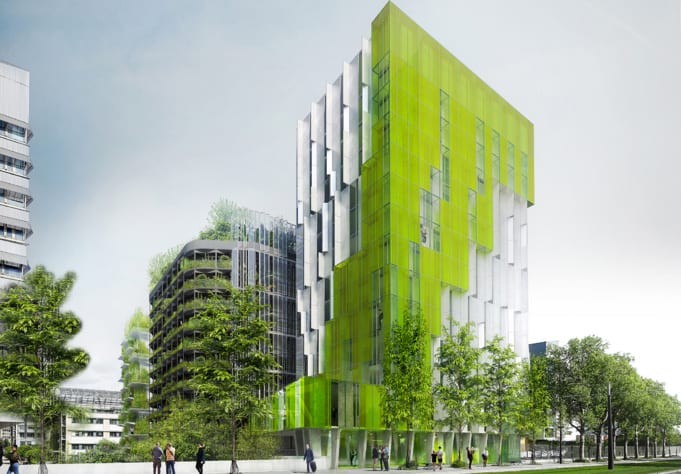
Growing algae on façades: it works!
5 minutes of reading
What if, tomorrow, we grew algae on building façades to produce food supplements, fuel and a number of other things? In France and in Germany, life-size experiments are yielding interesting results.

In Spring 2013, in Hamburg, a new residential building made the headlines. This building, “Bio Intelligent Quotient” (B.I.Q.), has four storeys featuring façade panes with algae cultures. Concretely, these are vertical and somewhat flat boxes, with glass making up the two largest façades, containing a liquid full of microscopic algae which gives them a greenish colour. The building’s technical design, developed by the Arup consultancy firm, features 127 panes installed on the façades which are the most exposed to the sun.
Why grow algae on façades?
The boxes, called bioreactors, provide a cultivation environment which enables the algae to multiply by capturing the light’s energy through photosynthesis. In Hamburg, these algae are then recovered and used as waste-to-energy to produce fuel for heating and thus avoid using fossil fuels. The liquid in the panes, heated by the sun, also serves to produce hot water using the same method as a thermal solar panel. This complex system greatly contributes to reducing the building’s energy consumption.
Since then, other uses have been considered. The Haematococcus Pluvalis alga, which has been tested as a façade pane culture, produces an antioxidant used as a dietary supplement. The possibility of producing plant proteins from algae such as Anthrospira has been discussed. Beyond their use for food, algae can provide polysaccharide powder used in cosmetics, and microalgae residues could make up one of the ingredients of bio-bitumen and constitute a bio-sourced raw material for public works. In addition, the phytoplankton could capture the CO2 in the atmosphere, just like the phytoplankton found in oceans: 1 cubic meter of micro-algae could have the same photosynthesis capacity as 80 to 100 trees.
Scientists are getting involved
In France, in 2015, the CNRS and the University of Nantes inaugurated the AlgoSolis platform in order to experiment on the solar culture of micro-algae. On a site measuring 2,000 square meters, researchers are testing various types of algae in different bioreactor models. This research enables the identification of the best technical systems for algae culture and the optimal configuration of the temperature, pH and nutrient settings. These settings, regulated by the bioreactors, differ for each plant species.
This technological progress has found its use in the construction industry thanks to the involvement of the CNRS and of the University of Nantes in the SymBIO2 consortium alongside the GEPEA, the OASIIS consultancy firm, the CSTB, several specialised companies and the XTU architectural firm. Architect Anouk Legendre wishes to promote the concept of symbiosis in construction: mutually-beneficial biological interactions between various living organisms.
Towards an industrialisation of façade panes?
The SymBIO2 experiment on bioreactors is already a success. The CSTB installed 200 square meters of bioreactors on the façade of its building in Champs-sur-Marne in 2016. During the first two years, the test served to evaluate the growth of two different types of algae offering different possibilities. This operational success should open the way to roll out this type of façade on entire buildings. The consortium thus participated in the In Vivo project, winner of the Reinventing Paris contest in 2016, in which the Algo House building project comprises a large surface of bioreactors as a curtain wall. Could this have been a first step towards the industrialisation of the technique in France, with the CSTB’s approval? For now, four years after the invitation to tender, construction has not yet started on this project.
The idea is also gaining momentum internationally. During a 2017 conference in Singapore, a group of researchers from the Georgia Institute of Technology suggested integrating algae-growing bioreactors into the BIM. This involves not just creating a BIM component corresponding to the pane, but also modelling the physical functioning of the pane to simulate the algae production capacity based on the orientation of the façades, sun and wind exposure, exterior temperature, etc.
Some people are even imagining new economic models based on algae culture. Urban Algae, a French start-up, offers property owners a chance to invest in bioreactors in the form of glass tubes which they would install on their roofs or façades. The start-up company will take care of the algae culture and give the owners a portion of the revenue from selling the algae.
However, the lack of concrete examples prevents a big-picture analysis of the concept of algae culture and its potential profitability. Aside from the impacts described above, the panes may have a bioclimatic role of reducing heat transmission in summer. But how effective is it? It seems that the productivity of these panes is slightly inferior to that of their industrial equivalent. Are property lessors and co-owners ready to take on the risk of maintaining these complex systems to draw these few advantages? We do not know. But there is no lack of ideas: namely a futuristic Chinese city dreamt by the XTU architectural firm, all in fluorescent green, which could meet its own energy and food needs thanks to building façades entirely covered in algae cultures.
More reading
Read also




What lies ahead? 7 megatrends and their influence on construction, real estate and urban development
Article
20 minutes of reading

